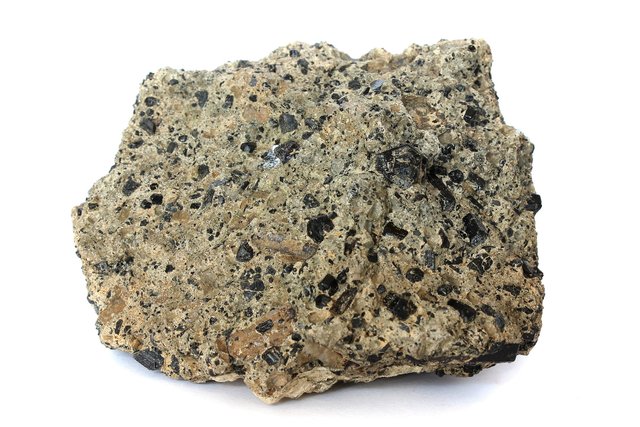
True as it is, cement has always find its use in constructional operations even in remote times - as far back as the twelveth century - though its earliest occurrence was claimed to been abouttwelve million years ago as a deposits. Well, you do not need to ponder if the form of cement found at that time is the same we make use of today- let me help you on that. Yes. However, the earliest known form of binder utilised by the early Roman and Macedonian builders is not the same as we have today. In fact, in construction, the term "binder" would best describe the essential material that our present day cement has come to prove as the most effective; materials that have the ability to glue or bind other materials, and in this case Sand. Binders would come in so many forms and compositions.

Wikimedia Creative Commons: A VolcanicTuff from Suletice, Czech republic Under Creative Commons Attribution 3.0 Unported
Lime found general acceptance as a choice binder until about the 16th century when another form of binder found its way to the construction scene. Tabby, such is the name of the new binder, was made entirely from oyster shells and water. Its production, quite labor-intensive, however proved to be worth it at the time of its adoption. It was produced from oyster shells crushed and burnt into quicklime which is then hydrated (slaked) and then mixed with sand, water and more shells. The resulting product is either poured in a mold to form bricks, which are used for construction, or utilized like present day concrete.

Geograph: Smematon's Tower Copyrighted by Wayland Smith Under Creative Commons Attribution 3.0 Unported
Here, he had a problem. The problem is with the setting time of the binders in existence at that time. These binders would take so much time to set that the coming high tides, occasional of the english water, wouldn't have a hard time sweeping a whole day's work along with it. This is quite a problem, one he was ready to conquer. Thus, he began to experiment with various forms of possible binding materials. Well, let your guess be as good as mine, he eventually stumbled upon one which actually paved way to the binder (cement) we have come to be very much familiar with this present day.
John Smeaton, while mixing different limestones with additives such as pozzolans (i.e clay), discovered that the setting ability of these samples are directly related to the clay content oof the limestone. What this simply mean is that they lime mixture tends to dry faster as their clay content increases. The basis of the production process of the commonly used present-day cement, portland cement. Portland cement is manufactured from the mixture of limestone, clay (or other pozzolanic materials) and several other additives.

Wikimedia Creative Commons: Power Plant Under Public Domain
It is estimated that 4100 million metric tonnes were produced globally, as at 2017 - quite a staggering amount of cement that is. This literally means that about 3690 million metric tonnes of Carbon (IV) Oxide was released into the atmosphere in 2017 from the production of cement alone. You will reckon that this is bad. Bad for every one. Its production, however, never ceases. And with a staggering rise in construction as at January 2018, cement production is expected to be on the increase.
So, What is this exposition all about?
Having established how much damage the production and use of cement of cement are causing to the environment, yet how much indispensable they are to the development of the modern world, it is quite essential that an alternative to this essential element of concrete be sort for. This, as a matter of fact, is the spirit behind this write up.
Well, first off, I am very glad to inform you about a bio-cement.
You heard right. Bio-Cement.
Bio-Cement
No doubt, technological development is on the rise daily. I really doubt if a regular tech user like myself can really keep with its development rate. It is daily on the rise and its impact is being felt in every aspect of the industries. Sustainable engineering necessitate technology development relating to construction materials, their production and manner of use. The proof of the participation of micro-organisms in the carbonate precipitation has guided researchers into probing the possibility of developing a bio-tech process into the production of cement and other construction material.
Microbial Induced Carbonation Procipitation (MICP) is the introduction of ureolytic bacteria.the precipitation process. A process whereby atmospheric Carbon (IV) Oxide combines with water at the time of rainfall to produce Carbonic Acid which impusively disassociate into hydrogen ions and bicarbonate. Dissolved Carbonate combines with dissolved Calcium to produce Calcium Carbonate. The Calcium Carbonate later crystallises into Calcite and Aragonite which are the core components of Limestone, a raw material for the production of cement. All these happen in the presence of the bacterial.
What results from the above process is called Bio-Cement.
The following, however, are the advantages of Bio-Cements over Ordinary Cements.
- Bio-cement requires a shorter time and lower temperature for production than ordinary cement needs.
- In-situ (or on-site) raw material of bio-cement are produced at very low temperature and energy, and emits lower carbon (IV) oxide and no hazardous environmental unlike Lime stone quarrying activity employed for the production of ordinary cement.
- The compressive strength of mortal produced with Bio-Cement is increased by 38%.
- Bio-Cements have the ability to remediate cracks in concrete structures and regain its original strength within a period of 28days (self-healing)
- Microbial cells used for the production of bio-cements can be produced using industrial by-products such as corn sheep liquor and lactose mother liquor.
- Concrete structure’s life are increased while the bricks durability an strength are increased too.
Conclusion
No doubt, cement remain one of the essential ingredient of concrete, a useful material in the construction industry. The production and use of cement releases harmful gasses into the atmosphere and also uses more energy particularly during production. Bio-Cement is the production of cement using a microbial induced process. This process reduces the need for energy for production and the emission of harmful gasses during production, and yet producing a more stronger product (concrete) than normal cement would. In addition, it has a self-healing ability. This means that a crack surfacing in a concrete made with bio-cement will seal up itself and retains its original strength, all In 28days. Bio-cement, definitely, is a necessity for future construction particularly for sustainable engineering and for environmental consideration.
I hope you learn one or two things today. Thank you once more for dropping by, and stay tuned for more of modern civil practices.
References:
GeoMika,
Cement - Wikipedia,
How Cement is Made - PCA,
Bio Cement –An Eco Friendly Construction Material - Paper by Reddy et. al.,
An Overview of Biocement Production from Microalgae - A journal by Dessy Ariyati et. al.,
ACS publication.
Thanks for sharing this detailed information with us. This post is being featured on @wafrica .
Courtesy of @nmalove
Downvoting a post can decrease pending rewards and make it less visible. Common reasons:
Submit
Hello! I find your post valuable for the wafrica community! Thanks for the great post! @wafrica is now following you! ALWAYs follow @wafrica and use the wafrica tag!
Downvoting a post can decrease pending rewards and make it less visible. Common reasons:
Submit
Thank you very much for finding this worthy for the community.
Downvoting a post can decrease pending rewards and make it less visible. Common reasons:
Submit
Thank you very much
For finding this worthy for
The community.
- abumaryam
I'm a bot. I detect haiku.
Downvoting a post can decrease pending rewards and make it less visible. Common reasons:
Submit
A very good post. But am I right if I say the Bio cement has a self restructuring ability, i.e after cracks it will build itself up back?
Downvoting a post can decrease pending rewards and make it less visible. Common reasons:
Submit
Yes, it does. Hopefully, i will address this in my next post. Kindly watch out for it.
Downvoting a post can decrease pending rewards and make it less visible. Common reasons:
Submit
Nice one bro!
Downvoting a post can decrease pending rewards and make it less visible. Common reasons:
Submit
Thank ypu.
Downvoting a post can decrease pending rewards and make it less visible. Common reasons:
Submit
I guess I've found where to get more knowledge on this aspect of engineering. Awesome, and surely i'd stay tuned for more. Thanks for sharing @abumaryam
Downvoting a post can decrease pending rewards and make it less visible. Common reasons:
Submit
Thank you very much @olajidekehinde., and thank you very much for stopping by.
Downvoting a post can decrease pending rewards and make it less visible. Common reasons:
Submit
This is really on point, I can relate this with dangote cement plant situated at ewekoro, ogun state, Nigeria.
Bio-cement is less harmful compare to ordinary cements. Thanks for the heads up.
Downvoting a post can decrease pending rewards and make it less visible. Common reasons:
Submit
This is true.
Downvoting a post can decrease pending rewards and make it less visible. Common reasons:
Submit
👍
Downvoting a post can decrease pending rewards and make it less visible. Common reasons:
Submit
Woops, Bio-cement.. That's quite new to my ears. They are indeed an upgrade.
Thanks for educating us on this...
Downvoting a post can decrease pending rewards and make it less visible. Common reasons:
Submit
Thank you very much for stoppin by.
Downvoting a post can decrease pending rewards and make it less visible. Common reasons:
Submit
@abumaryam, this is really intresting topic, i will like to know, if this bio-cement is as dusty like ordinary?
Downvoting a post can decrease pending rewards and make it less visible. Common reasons:
Submit
It has fine particles too just as ordinary cement does.
Downvoting a post can decrease pending rewards and make it less visible. Common reasons:
Submit
Hmm bio cement. The part I like best about it was the fact that it self heals. That's pretty cool.
Downvoting a post can decrease pending rewards and make it less visible. Common reasons:
Submit
Thank you @quantum-wave for stopping by. Sure, it does heal itself, and I do hope to discuss this in my last post.
Downvoting a post can decrease pending rewards and make it less visible. Common reasons:
Submit
Wow! I didnt learn a thing or two, I learnt plenty! Who knew cement could be contributing to pollution? Interesting! Thanks for this
Downvoting a post can decrease pending rewards and make it less visible. Common reasons:
Submit
You are welcome@mosunomotunde. And thank you very much for stopping by.
Downvoting a post can decrease pending rewards and make it less visible. Common reasons:
Submit
Hi @abumaryam!
Your post was upvoted by utopian.io in cooperation with steemstem - supporting knowledge, innovation and technological advancement on the Steem Blockchain.
Contribute to Open Source with utopian.io
Learn how to contribute on our website and join the new open source economy.
Want to chat? Join the Utopian Community on Discord https://discord.gg/h52nFrV
Downvoting a post can decrease pending rewards and make it less visible. Common reasons:
Submit
Yes...i totally agree with you.....thanks for this vital information....well done bro
Downvoting a post can decrease pending rewards and make it less visible. Common reasons:
Submit
Thank you very much.
Downvoting a post can decrease pending rewards and make it less visible. Common reasons:
Submit
Wow! Bio cement is really the real deal. its nice to know that steps are being taken to reduce the emissions during cement production.
the only problem is, how fast the industries are willing to adopt this
Downvoting a post can decrease pending rewards and make it less visible. Common reasons:
Submit
Bio cements usually cost more than ordinary cement but on the long run, it pays. Its ability to self-heal, which i hope to discuss in my next post, makes maintenance on structures built with it quite low unlike those built with ordinary cements.
Downvoting a post can decrease pending rewards and make it less visible. Common reasons:
Submit
Am reading about bio-cement for the first time and I found this quite informative. So the concrete blocks made with bio-cement can seal up itself when cracked. Well done @abumaryam
Downvoting a post can decrease pending rewards and make it less visible. Common reasons:
Submit
Wow...this is the best article for the month
Downvoting a post can decrease pending rewards and make it less visible. Common reasons:
Submit
I agree with you. I definitely got to know a lot about cement which I never knew before. Nice one @abumaryam
Downvoting a post can decrease pending rewards and make it less visible. Common reasons:
Submit
ok ! bio cement, new to me, but it was quite educating. thanks for sharing
Downvoting a post can decrease pending rewards and make it less visible. Common reasons:
Submit